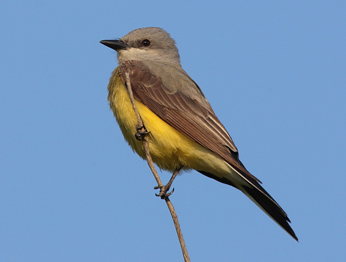Kingbirds catch flies in Coors Field—and without mitts
May 17, 2010 - by Staff
May 17, 2010 - by Staff
Margaret LeMone | 17 May 2010 • On May 14, we took look lots of extra clothes to the Colorado Rockies baseball game: the temperature was in the upper 50s Fahrenheit in downtown Denver, and it was supposed to dip to below 50 overnight. We were going to be ready.
When we heard the forecast, we didn’t think about what this would do to insects: we don’t normally associate Coors Field with a lot of bugs. But, on this particular night we had a lesson on how the temperature affects insects, and thus the behavior of insect-catching birds—in this case, a pair of western kingbirds.
A few years ago, I wrote a blog post (http://classic.globe.gov/fsl/scientistsblog/2007/10, Oct 5th) on estimating the temperature from counting cricket chirps. After gathering data during the night for several months, I confirmed the widely circulated linear relationship between cricket chirps and temperature. While gathering the data, I noticed that the crickets stopped chirping below around 50°F (10°C). This is also the temperature below which radar meteorologists no longer see insect echoes. In both cases, insect activity seems to slow down to almost nothing at that temperature.
What does a baseball game have to do with kingbirds and temperatures?

Western kingbird. (Photo courtesy Wikipedia Commons.)
As we were settling into our seats, we noticed a bird perched on the wire just above our seats in Section 134 of Coors Field. It was so close—within 30 feet (9 meters) of our seats, but neither my husband nor I could identify the bird in the late-afternoon shadows, even after getting up to look closer. It wasn’t a pigeon or a house sparrow, two birds you might expect to appear in an urban setting with a lot of people. After we sat down and wrote down the description of the bird, the man next to me said, “That’s a western kingbird. Notice that it is behaving like a flycatcher."
As we watched, the bird would fly a short distance, grab something in mid-air, and then return to the wire in a slightly different place. That was the right behavior for a kingbird. But in the fading sunlight, its yellow breast looked gray. As we watched, and the Coors field lights grew brighter, we could see the yellow breast more clearly.
We watched the bird as it caught a bug, then landed farther down the wire above us, caught another bug, and then landed on another wire, working its way down toward outer left field to our left. Then we discovered a second western kingbird to our right. The two birds caught flies in different parts of the stadium—sometimes at the opposite ends, seemingly oblivious to each other’s presence.
Then, something curious happened. The two birds converged on the opposite (southwest-facing) side of the field from us, where they hunted for a few more minutes together, before going up to catch insects near the lights. They did this for about a half hour, and then, quite abruptly, flew together southwestward over left field and out of the stadium. By this time, many of the people in our section, including a couple in the row in front of us who had binoculars, were watching the birds’ antics as well as the game.
Why the two kingbirds found Coors Field a good place to hunt for food, I don’t know. The 35,000 fans, cheers, and flying baseballs did not seem to disturb the birds. But I do think that their hunting methods were related to the temperature. When the temperature in the stadium was still in the 50s, the birds could hunt for insects from the wires above us in the shady part of the field. But once the temperature got cool enough, the insects were no longer active on our side of the field. Going to the opposite side of the field, where the fading sunlight could have made the temperature a little warmer, bought a little bit more time for hunting insects, until the temperature dropped there, too. Finally, that part of the field got too cool also, so the only warm place left was near the lights.
The lights are not only warm, but they attract insects. Apparently the kingbirds figured that out, and so they stayed to get a little more food.
I’m not sure why the birds left when they did. Perhaps it was because the temperature cooled enough so that the catchable insects were too close to the lights, or they wanted to go home, or they just had eaten their fill.
It's apparent that the kingbirds like Coors Field. We watched the game today on television and could see at least one bird (presumably the kingbird) catching insects above the field. Obviously this pair has found a good thing—worth the bother of all those noisy people!